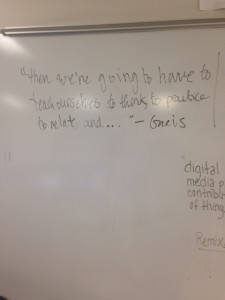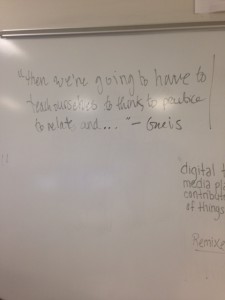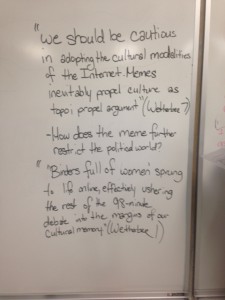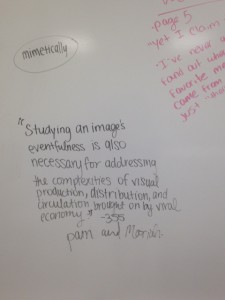Focusing on Attention Structures – Jones & Hafner (pg82 – 97)
Key Concepts:
Multitasking & Partial Attention (82)
“Digital Media and Polyfocality” (83)
“One important though sometimes neglected literacies is this ability to use digital tools to manage, distribute, and focus attention”
Cast switching – switch from one activity to another
Dual activity – paying attention to two important things; switching back and forth
Continual partial attention – constantly but partially, attending to the information from their communication devices, motivated by the fear of ‘missing something’ (82)
Example of Fola
Analog – doing laundry, watering grass, taking niece to park
Digitally – switching back and forth in tabs
- Is this multitasking and what type?
- How do we categorize this?
- Is this meta-cognitive multitasking?
- Does the concept of, “In the background” alter multitasking?
- What is considered noise in multitasking?
Managing attention:
- Making yourself unavailable
- Get attention when you give attention
- Always on (Participation and Interaction)
Branching – which involves keeping a goal in mind but allocating time for other things. (84, last paragraph) links to polyfocality( directing attention to more than one focal point) !!Not just in digital spaces!!
Attentional tracks – distribute attention among a variety of different things such as conversations (85)
“Paying attention means more than just saying focusing your mental energy on a particular exchange, remembering who you are talking to and what you are talking about. it also involves sending appropriate signals or feedback to other participants in order to show them what you are paying attention” (85)
Attention Structures (87) –
“Attention structures are the technology means used by people to make sense of the over abundance of information that they face in the digital age” which are effected by the 3 elements :
- Historical body – You and Your mind
- Interaction order – Your relation with the people around you
- discourses in place – The communication tools available in the situation
(overlap in the social action)
“The Attention Economy and Digital Literacies” (90)
Attention economy – where value is created from the exchange of attention and ‘[w]hat matters is seeking, obtaining and paying attention’
- facilitate participation by creating new channels for distributing attention
- creates other types values
Illusory attention – give the illusion of personal attention even though they are addressing a large audience.
- automatic replies
- away message
- filtering
- ‘boomeranging’ (branching)
- reminders
“Ideas become popular, and then become more popular based on the fact that they are popular in the first place, just like search results on google. Originating a meme, or playing a significant role in its distribution, is one way of attracting attention.” (91)
“In order to attract attention effectively, one also needs to gain some understanding of how social filters (see Chapter 2) function and amplifying information and in distributing and drawing people’s attention to content.” (92)
“while digital media have undoubtedly given people the tools with which attract attention, some are concerned that this is leading people to do ‘anything’ as long as it gets attention.” (92)
Social Media case study (92-93)
Hashtags
- demands attention
- enables and localizes participation
- paying selective attention
- categories
- What type of multitasking device is a hashtag?
- How have hashtags, favoriting, bookmarking changed out ability to attention?
Singling out
- ‘@’ a person, place, or thing
- gives explicit attention
How to Gain Attention Online (95) –
- Do some something cool and/or stupid
- Be controversial
- Interview cool people;
- Post pictures and videos;
- Give your work a great title;
- Write a guest post for a large blog
- Leave comments and relevant blogs or social media channels;
- Create a poll
What different strategies do social media platforms allocate to gain attention?
- Notification in various places (email, popups, forwarding, etc.)
- quick, popular, invites participation
- gets point across by multimodality
- is not overwhelming
How does this event generate or incorporate the following topics:
- Visual rhetoric
- Emotional appeal
- Multimodality
- Circulation
- Virality
- Attention
- Eventfulness
- Provocativity
Reminders –
- Keep in mind the Lebduska in mind and be prepared for discussion
- Check schedule for update
- 11/3 and 11/5 working on project based work in class
- Mid-semester reflection 1-2 pages single spaced Document emailed to Professor Belli by sunday night 11/01
- How have you developed as a writer, in major, professionally?
- How have you grown?
- What have your gravitated towards ie. topics?
- Are there specific topics you are interested in perusing for final project?








